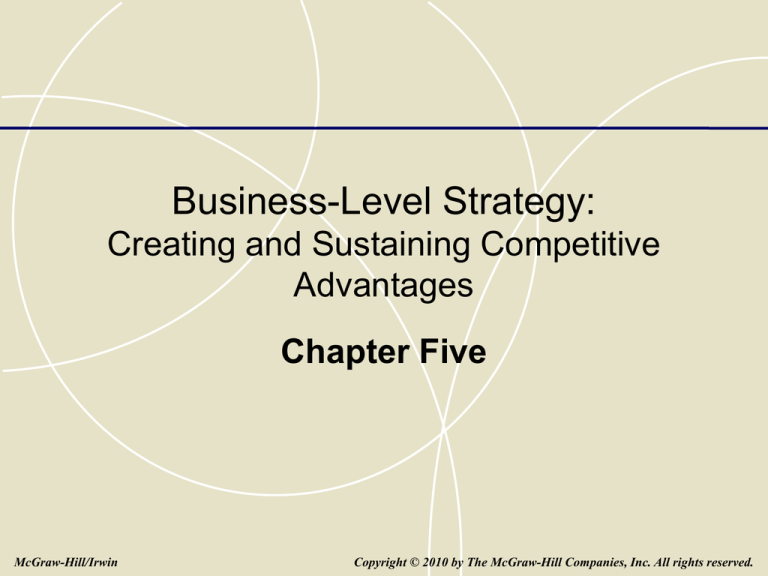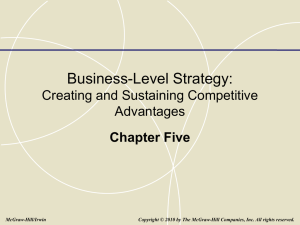
Business-Level Strategy:
Creating and Sustaining Competitive
Advantages
Chapter Five
McGraw-Hill/Irwin
Copyright © 2010 by The McGraw-Hill Companies, Inc. All rights reserved.
Three Generic Strategies
5-2
Three Generic Strategies
• Overall cost leadership
Low-cost-position relative to a firm’s peers
Manage relationships throughout the entire
value chain
• Differentiation
Create products and/or services that are
unique and valued
Non-price attributes for which customers will
pay a premium
5-3
Three Generic Strategies
• Focus strategy
Narrow product lines, buyer segments, or
targeted geographic markets
Attain advantages either through
differentiation or cost leadership
5-4
Example
• Companies pursuing an overall cost
leadership strategy
McDonalds
Wal-Mart
• Companies pursuing a differentiation strategy
Harley Davison
Apple
• Companies pursuing a focus strategy
Rolex
Lamborghini
5-5
Competitive Advantage and
Business Performance
5-6
Overall Cost Leadership
Tight set of interrelated tactics that
includes:
• Tight cost and overhead control
• Avoidance of marginal customer accounts
• Cost minimization in all activities in the firm’s
value chain
5-7
Overall Cost Leadership
• Experience curve
refers to how business “learns” to lower costs
as it gains experience with production
processes
with experience, unit costs of production
decline as output
increases in most
industries
5-8
Overall Cost Leadership (Cont.)
• Parity on the basis of differentiation
Permits a cost leader to translate cost
advantages directly into higher profits than
competitors
Allows firm to earn above-average profits
5-9
Comparing Experience Curve Effects
5-10
Improving Competitive Position vis-à-vis the Five
Forces
An overall low-cost position
• Protects a firm against
rivalry from competitors
• Protects a firm against
powerful buyers
• Provides more flexibility
to cope with demands
from powerful suppliers
for input cost increases
• Provides substantial entry
barriers from economies
of scale and cost
advantages
• Puts the firm in a
favorable position with
respect to substitute
products
5-11
Differentiation
•
•
•
•
•
•
Prestige or brand image
Technology
Innovation
Features
Customer service
Dealer network
5-12
Differentiation
• Firms may differentiate along several
dimensions at once
• Successful differentiation requires integration
with all parts of a firm’s value chain
• An important aspect of differentiation is speed or
quick response
5-13
Differentiation: Improving Competitive
Position
• Creates higher entry barriers due to customer
loyalty
• Provides higher margins that enable the firm to
deal with supplier power
• Establishes customer loyalty and hence less
threat from substitutes
5-14
QUESTION
High product differentiation is generally
accompanied by
A. Higher market share
B. Decreased emphasis on competition
based on price
C. Higher profit margins and lower costs
D. Significant economies of scale
5-15
Focus
• Focus is based on the choice of a narrow
competitive scope within an industry
Firm selects a segment or group of segments
(niche) and tailors its strategy to serve them
Firm achieves competitive advantages by
dedicating itself to these segments
exclusively
5-16
Focus
• Cost focus
firm strives to create a cost advantage in its
target segment
• Differentiation focus
firm seeks to differentiate in its target market
5-17
Focus: Improving Competitive Position
• Focus
Creates barriers of either cost leadership or
differentiation, or both
Used to select niches that are least
vulnerable to substitutes or where
competitors are weakest
5-18
U.S. Automobile Industry’s Profit Pool
5-19
Internet-Enabled Low Cost Leader
Strategies
• Online bidding and
• Online purchase
order processing are
orders are making
eliminating the need
many transactions
for sales calls and are
paperless, thus
minimizing sales force
reducing the costs of
expenses.
procurement and
paper.
5-20
Internet-Enabled Differentiation
Strategies
• Internet-based
knowledge
management systems
that link all parts of
the organization are
shortening response
times and
accelerating
organization learning.
• Quick online
responses to service
requests and rapid
feedback to customer
surveys and product
promotions are
enhancing marketing
efforts.
5-21
Internet-Enabled Focus Strategies
• Permission marketing techniques are
focusing sales efforts on specific
customers who opt to receive advertising
notices.
• Niche portals that target specific groups
are providing advertisers with access to
viewers with specialized interests.
5-22
Industry Life-Cycle Stages:
Strategic Implications
• Industry life cycle
refers to the stages of introduction, growth,
maturity, and decline that occur over the life
of an industry
5-23
Stages of the
Industry Life
Cycle
5-24
QUESTION
The most likely time to pursue a harvest
strategy is in a situation of
A. High growth
B. Strong competitive advantage
C. Mergers and acquisitions
D. Decline in the market life cycle
5-25
Industry Life-Cycle Strategies
In the Introduction Stage:
• Products are unfamiliar to consumers
• Market segments not well defined
• Product features not clearly specified
• Competition tends to be limited
5-26
Industry Life-Cycle Strategies
For the Introduction Stage:
• Develop product and get users to try it
• Generate exposure so product becomes
“standard”
5-27
Industry Life-Cycle Strategies
The Growth Stage is:
• Characterized by
strong increases in
sales
• Attractive to potential
competitors
5-28
Industry Life-Cycle Strategies
For the Growth Stage:
• Brand recognition
• Differentiated products
• Financial resources to support value-chain
activities
5-29
Industry Life-Cycle Strategies
In the Maturity stage:
• Aggregate industry demand slows
• Market becomes saturated, few new
adopters
• Direct competition becomes predominant
• Marginal competitors begin to exit
5-30
Industry Life-Cycle Strategies
For the Maturity Stage:
• Efficient manufacturing operations and
process engineering
• Low costs (customers become price
sensitive)
5-31
Industry Life-Cycle Strategies
In the Decline Stage:
• Industry sales and profits begin to fall
• Strategic options become dependent on
the actions of rivals
5-32
Strategies in the Decline Stage
For the Decline Stage
• Maintaining
• Exiting the market
• Harvesting
• Consolidation
5-33
Turnaround Strategies in the Life Cycle
• Turnaround strategy
a strategy that reverses a firm’s decline in
performance and returns it to growth and
profitability.
• Asset and cost surgery
• Selective product and market pruning
• Piecemeal productivity improvements
5-34












